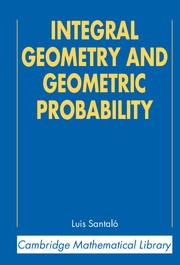Book contents
- Frontmatter
- Contents
- Editor's Statement
- Foreword
- Preface
- Integral Geometry and Geometric Probability
- Part I INTEGRAL GEOMETRY IN THE PLANE
- Part II GENERAL INTEGRAL GEOMETRY
- Part III INTEGRAL GEOMETRY IN En
- Part IV INTEGRAL GEOMETRY IN SPACES OF CONSTANT CURVATURE
- Appendix Differential Forms and Exterior Calculus
- Bibliography and References
- Author Index
- Subject Index
Preface
Published online by Cambridge University Press: 28 January 2010
- Frontmatter
- Contents
- Editor's Statement
- Foreword
- Preface
- Integral Geometry and Geometric Probability
- Part I INTEGRAL GEOMETRY IN THE PLANE
- Part II GENERAL INTEGRAL GEOMETRY
- Part III INTEGRAL GEOMETRY IN En
- Part IV INTEGRAL GEOMETRY IN SPACES OF CONSTANT CURVATURE
- Appendix Differential Forms and Exterior Calculus
- Bibliography and References
- Author Index
- Subject Index
Summary
During the years 1935–1939, W. Blaschke and his school in the Mathematics Seminar of the University of Hamburg initiated a series of papers under the generic title “Integral Geometry.” Most of the problems treated had their roots in the classical theory of geometric probability and one of the project's main purposes was to investigate whether these probabilistic ideas could be fruitfully applied to obtain results of geometric interest, particularly in the fields of convex bodies and differential geometry in the large. The contents of this early work were included in Blaschke's book Vorlesungen iiber Integralgeometrie [51].
To apply the idea of probability to random elements that are geometric objects (such as points, lines, geodesies, congruent sets, motions, or affinities), it is necessary, first, to define a measure for such sets of elements. Then, the evaluation of this measure for specific sets sometimes leads to remarkable consequences of a purely geometric character, in which the idea of probability turns out to be accidental. The definition of such a measure depends on the geometry with which we are dealing. According to Klein's famous Erlangen Program (1872), the criterion that distinguishes one geometry from another is the group of transformations under which the propositions remain valid. Thus, for the purposes of integral geometry, it seems natural to choose the measure in such a way that it remains invariant under the corresponding group of transformations. This sequence of underlying mathematical concepts – probability, measure, groups, and geometry – forms the basis of integral geometry.
- Type
- Chapter
- Information
- Integral Geometry and Geometric Probability , pp. xv - xviiiPublisher: Cambridge University PressPrint publication year: 2004



